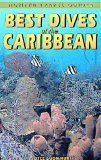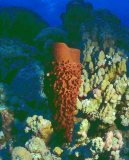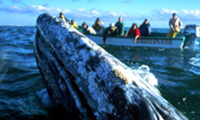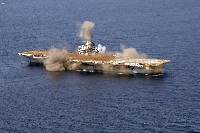Friday, May 26, 2006
Interview with Diving Author Joyce Huber

Joyce Huber's first book was a travel guide for divers titled Best Dives of the Caribbean. The original was published in 1988, but an updated version is out this month.
This first diving book spawned another on the sea - Best Dives' Snorkeling Adventures. This came about when she put her email address in an edition of the diving book, and was inundated with questions. Not from divers but from snorkellers.
After many nights staying up until 3 am answering the e-mails, Huber decided the snorkellers should have their own book. Her publisher, Michael Hunter, didn't see a market in snorkelling, but she had worked in print for so many years that it seemed simple enough for her to put a snorkelling guide together for them. It is now in its third edition.
Her scuba diving guide has been in need of an upate for a few years - but she put it on hold as her co-author/dive buddy/husband was diagnosed with brain cancer in 2002. He died in 2003. She was so devastated she did nothing till 2005. His name as co-author is on the new edition of the guide as he contributed much time to it.
The first dive book was the result of 20 years of dive travel and note taking. Back in the 1970's, Joyce and her husband Jon put on slide shows of underwater sites for their local dive club. Friends asked about places to stay, best time of year, where to eat etc. It grew into a book from there.
Joyce signed a contract with Dodd Mead publishing, but the publishing company folded. Putnam Publishing bought out the contract. They dropped "Best Dives". Since she was a new writer, she hired a crusty editor - Eliot Tozer - to make the book more saleable. He got hooked on the subject and took off for Bermuda for a resort course. He nearly drowned when his mustache let water in his mask.
Simon and Schuster's editor then wanted the book, but she was over-ruled as no one had ever published a dive-travel guide and they didn't want to be the first. Meanwhile, Michael Hunter started a travel book company. He moved to south Florida and lived on the beach where he saw lots of divers going in and out of the ocean so he figured there must be a market. He published the first Best Dives book in 1988 and it was an instant success. "We meant it to be for new divers" says Joyce "but everyone loved it."
You might imagine that writers on diving have been a major influence on Joyce Huber, but oddly enough she sites instead people from Flying Magaine and Aviation International News. She worked on aviation magazines as an art director for many years and in corporate and general aviation doing promotional work. She is a licensed seaplane pilot.
Huber grew up in northeastern New Jersey, an area that is a suburb of New York City. She spent summers in south Jersey swimming and beach-combing and watching seaplanes. After studying art at Pratt Institute and the Art Students League she worked as everything from a fashion designer to a mural painter. She went back to school for writing specifically to do the dive books when she was 35 years old. She's now 58 now.
Joyce Huber's books are available from Amazon, with up to 35% off.
Best Dives in the Caribbean is available from:
amazon.com and amazon.co.uk
Best Dives' Snorkeling Adventures is available from:
amazon.com and amazon.co.uk
--
Subscribe to SCUBA News (ISSN 1476-8011) for more free news, articles, diving reports and marine life descriptions - http://www.scubatravel.co.uk/news.html

Labels: books
Thursday, May 25, 2006
Creature of the Month: Tube Sponge, Acervochalina sp
 With their varied colours and intricate shapes, sponges
With their varied colours and intricate shapes, spongesadd beauty to the reef or rock. Some sponges are
greenish, violet or pinkish in colour because they
harbour symbiotic algae. The more symbionts and light,
the stronger the colour. When there is low light
these sponges are a much paler colour - almost
white.
The sponge uses the algae as a source of oxygen, a
screen against sunlight and as a food source. The
algae profit by a secure habitat.
Sponges are amongst the simplest members of the animal
kingdom. They have no digestive, nervous or
circulatory systems for example.
The lack of sophistication in sponges has been shown in
a classic experiment. A sponge was pushed through fine
silk to completely break it down. However, it soon
succeeded in resassembling itself.
A sponge feeds by drawing water into its central cavity
through its pores - the tiny holes covering its body.
The filtered water leaves through the big outlet pores.
Our picture (http://www.scubatravel.co.uk/sponge.html)
shows a Tube sponge, Acervochalina species. This sponge
can produce a chemical which is highly toxic to
Pocillopora and Acropora corals.
Further Reading:
----------------
Great British Marine Animals, Paul Naylor
http://www.scubatravel.co.uk/britishmarine.html
The Red Sea in Egypt Part II, Farid S Atiya
--
Subscribe to SCUBA News (ISSN 1476-8011) for more free news, articles, diving reports and marine life descriptions - http://www.scubatravel.co.uk/news.html

Labels: sealife
Friday, May 19, 2006
Why was Sipadan Damaged?
Well, it turns out that the barge operators had been given a contract to build tourist facilities such as toilets and restaurants on the island (source: Malaysian National News Agency).
When the Deputy Chief Minister of Sabah (who is also Tourism, Environment and Culture Minister) was asked how the barge could sail to the protected island, he said the contractor who was involved in the project was not given any approval by Sabah Parks to use such a huge vessel to transport the building materials or equipment.
Asked whether the contract would be terminated, he said:
"We have to wait and see... the contractor has been very cooperative and has admitted the faults."Not, I suspect, what divers around the world wanted to hear.
--
Subscribe to SCUBA News (ISSN 1476-8011) for more free news, articles, diving reports and marine life descriptions - http://www.scubatravel.co.uk/news.html

Win an iPod with Humpback Whale Mix

The International Fund for Animal Welfare (IFAW) this week launched the “Whale Remix Project,” a novel online contest where you can create your own song using the sounds of the humpback whale. A celebrity panel will judge the top ten songs selected by IFAW. The winner will receive a 60GB video iPod and have their song featured in upcoming public service announcements about illegal commercial whaling.
“This contest provides a fun way to connect people with these magnificent creatures and their unique songs, and to promote citizen action to protect them in the face of a new whaling offensive by Japan,” said Greg Wetstone, U.S. director for IFAW. “We hope this effort will encourage music pros and amateurs alike to take an interest in the future of the planet’s whales, and especially the endangered humpback.”
The Whale Remix Project can be found at www.stopwhaling.org. The contest ends June 11, 2006 at 11:59 p.m. PDT. Winners will be announced July 3, 2006. In addition to the 60GB video iPod for the top winner, runners-up could win an iPod Nano or iPod Shuffle.
“The humpback whale sings a beautiful song that must never be silenced by illegal whaling,” said Dr. Roger Payne, the scientist who discovered that humpback whales sing and creator of the album, Songs of the Humpback Whale, the best selling natural history recording ever released. “Human activity already places tremendous stress on whale populations struggling to come back from humanity’s long history of whaling. Japan’s growing commercial whaling is an added strain that could be too much for several whale species.”
--
Subscribe to SCUBA News (ISSN 1476-8011) for more free news, articles, diving reports and marine life descriptions - http://www.scubatravel.co.uk/news.html

Thursday, May 18, 2006
Warship wrecked for SCUBA Divers

An ex-warship of the US navy was sunk yesterday to become the largest artificial reef in the world.
The navy has been working with environmental groups to prepare for the sinking since 2003. It conducted several scientific studies to make sure that the USS Oriskany would create an environmentally safe reef on the Florida seabed.
The ship was sunk at a depth of 65 m (212 feet) at mean low water. This means that the shallowest part of the vessel will be deeper than 19 m (61 feet).
The 270 m (888 feet) ship took about 37 minutes to sink below the surface.
Modifications have been made to the ship for the safety of recreational divers. These include the removal of protrusions on bulkheads, and of glass from windows. You can't dive it yet though: diving is currently restricted to allow for the possibility of air venting.
The reefing of the ex-ORISKANY is the start of a completely new program for the Navy. It is the first vessel that the Navy has sunk intentionally to form an artificial reef.
More ships are to be offered for artificial reefs later this year.
Source: Navy Newstand
--
Subscribe to SCUBA News (ISSN 1476-8011) for more free news, articles, diving reports and marine life descriptions - http://www.scubatravel.co.uk/news.html

Wednesday, May 17, 2006
Barge Damages Sipadan
All diving operators and resorts had to leave the island of Sipadan on environmental grounds a couple of years ago: so what was the barge doing there?
According to Andrea and Antonella Ferrari, authors of A divers' guide to Underwater Malaysia Macrolife,
"The damage is incalculable — one of Sipadan’s most precious and beloved spots, well-known the world over, is no more, transformed by a single inexplicable act of human carelessness into a grisly mass of broken and pulverised corals, shredded turtles and mounds of grey gravel suffocating what little is left of the legendary drop-off."
The barge was anchored next to the drop-off. Sipadan is a limestone pinnacle rising from 600 m. It is not far from the East coast of Sabah, Malaysia.
Source: Fins Magazine
--
Subscribe to SCUBA News (ISSN 1476-8011) for more free news, articles, diving reports and marine life descriptions - http://www.scubatravel.co.uk/news.html

Labels: SCUBA Travel
Tuesday, May 16, 2006
Protest at Shell's Threat to Grey Whales
Shell's Sakhalin II project in Russia's far east is the largest oil and gas extraction project in the world and they are seeking up to $300 million from the European Bank for Reconstruction and Development (EBRD).
Despite the warnings of scientists that this project could drive the whales to extinction, the European Bank looks set to back the project with public funds.
The western Pacific stock of Grey Whales (Eschrichtius robustus) has only about 100 animals remaining - of which just 23 are reproductive females.
The whales have already suffered during the first phase3 of the Sakhalin Energy project, which went into production five years ago. Scared away from their feeding grounds, the whales became emaciated and fewer calves were born. Environmental organisations are concerned that the next phase, which would run an undersea pipeline directly through their feeding grounds and place a platform even closer to them, is a major threat to the whale's survival.
If you would like to attend the protest it is on 22 May, 10.30 am to 2.30 pm at the Hilton Metropole Hotel, Junction of Edgware Road (by the flyover) and Praed Street, London W2. To protest by e-mail contact sakhalinfeedback@ebrd.com.
--
Subscribe to SCUBA News (ISSN 1476-8011) for more free news, articles, diving reports and marine life descriptions - http://www.scubatravel.co.uk/news.html

Friday, May 12, 2006
Fingernail Furrows Found on Saturation Divers
All divers performed hard work on bicycle ergometers during the dives.
Beau's lines have been reported in numerous medical conditions such as typhus, rheumatic fever, malaria, myocardial infarction, and other severe metabolic stresses. To the researcher's knowledge this is the first report of Beau's lines associated with saturation diving.
Journal Reference: Undersea Hyperb Med. 2006 Jan-Feb;33(1):5-10.
--
Subscribe to SCUBA News (ISSN 1476-8011) for more free news, articles, diving reports and marine life descriptions - http://www.scubatravel.co.uk/news.html

Thursday, May 04, 2006
40 Percent of Species Threatened with Extinction
 The IUCN Red List of Threatened Species has found that two in five organisms are threatened with extinction.
The IUCN Red List of Threatened Species has found that two in five organisms are threatened with extinction. Large marine animals top the extinction risk categories . From sharks to rays, wrasses and whales, the picture painted by this year’s Red List is far from encouraging for the ocean’s heftier inhabitants.
"The findings underline the plight of many species throughout the world’s seas and
oceans, from the Mediterranean to Chinese coasts. Animals that are part of our heritage and have been around since the age of the dinosaurs are now going down the drain,” warns Carl Gustaf Lundin, Head of the IUCN Global Marine Programme.
Sharks and rays are among the first marine groups to be systematically assessed, and of the 547 species listed, 20% are threatened with extinction. This confirms suspicions that these mainly slow-growing species are exceptionally susceptible to over-fishing and are disappearing at an unprecedented rate across the globe.
The Angel shark (Squatina squatina), previously assessed as Vulnerable, has jumped up two categories and is now classed as Critically Endangered, the top threat category. Many of its peers are following the same path. For example, the gulper shark (Centrophorus granulosus) has declined by 80-95% in its main range within the Northeast Atlantic whilst the Australian endemic Harrison’s dogfish (Centrophorus harrissoni) has undergone an even more dramatic decline of over 99% in two decades, fuelled by demand from the fisheries and cosmetics industries.
Sharks, like other large marine species which have naturally slow reproduction and repopulation rates, suffer mostly from overfishing, as well as being killed as bycatch. “As human beings, we can only point the finger at ourselves,” notes Sarah Fowler, Co-Chair of the Shark Specialist Group of the IUCN Species Survival Commission (SSC), “We are the ones driving amazing creatures to extinction.”
“Marine species are proving to be just as much at risk of extinction as their land-based counterparts: the desperate situation of many sharks and rays is just the tip of the iceberg,” said Craig Hilton-Taylor of the IUCN Red List Unit. “It is critical that urgent action to greatly improve management practices and implement conservation measures, such as agreed non-fishing areas, enforced mesh-size regulations and international catch limits, is taken before it is too late.”
Other large creatures such as the Humphead wrasse, the Giant Yellow croaker or the Goliath grouper already benefit from the protection of international treaties such as the Convention on International Trade in Endangered Species of Wild Flora and Fauna (CITES), yet are showing little improvement.
The Humphead wrasse, Napoleon or Maori wrasse (Cheilinus undulatus), a mammoth among coral reef fishes, occurred extensively throughout much of the Indo-Pacific region. Because it is widely threatened, especially by the international live food-fish trade which exerts a high demand for its “plate-sized” juveniles, it is declining in much of its geographic range. Although it is listed as Endangered, uplisted from Vulnerable in 2004, on the IUCN Red List and on Appendix II of CITES, which restricts international
trade in this species, some countries have taken one step further to avert its disappearance from the wild.
Indonesia, its major exporting country, has sharply reduced the export quota to an interim measure of 8,000 fish per year, whilst Hong Kong plans to introduce legislation even more restrictive than that of CITES. Workshops and information campaigns in South-East Asia are also helping to raise public awareness about this species.
“In a dedicated effort to save this wrasse, IUCN, through its Groupers & Wrasses Specialist Group, is working with the Indonesian and Hong Kong Governments to ensure the best knowledge and expertise is available to give the species a hand,” says Dr Yvonne Sadovy, Associate Professor at Hong Kong University and Chair of the IUCN SSC Groupers & Wrasses Specialist Group.
Notwithstanding the daunting statistics unveiled in this year’s IUCN Red List, there is light at the end of the tunnel for some endangered species. The Goliath grouper, which is the largest of all coral reef fishes attaining some two meters in length, entered the IUCN Red List as Endangered in 1996. While it is still in the same category today, encouraging signs of recovery have been reported in southeastern USA, with juvenile densities relatively high in key mangrove areas. This trend is attributed to the availability of good quality habitat and to the effects of a fishing moratorium introduced by the USA in 1990.
“Although the situation is dramatic for many species in most of the world’s waters, there is definitely a ray of hope,” underlined Lundin, “the Goliath grouper shows that progress can be made, no matter how bleak the outlook, so the time to act is now before we lose the marine life that sustains our planet and ourselves.”
--
Subscribe to SCUBA News (ISSN 1476-8011) for more free news, articles, diving reports and marine life descriptions - http://www.scubatravel.co.uk/news.html

Labels: environment
Wednesday, May 03, 2006
International Sea Turtle Swimway Proposed
“Some 650 scientists from 64 different countries attended the symposium and many of them recognize that the Kemp’s ridley has
begun recovering from near extinction and needs much more protection in both U.S. and Mexican waters,” said Carole Allen, Gulf Office Director of the Sea Turtle Restoration Project and founder of HEART (Help Endangered Animals-Ridley Sea Turtles).
A second resolution addresses the revision of the 1992 Recovery Plan for the Kemp’s ridley now underway by the U.S. Fish and Wildlife Service and National Marine Fisheries Service. It recommends that the new recovery plan recognizes and designates the Texas coast as nesting habitat and the adjoining waters as important migratory and foraging habitat. Last year 51 Kemp’s ridley nests were found on the Texas coast.
“So far this month, 13 dead sea turtles have been found on Texas beaches as shrimping activity increases. More law enforcement is needed immediately to make sure Turtle Excluder Devices are being used properly on shrimp trawls,” Allen said. “We have also learned that a female Kemp’s ridley raised and released in Galveston waters in 1993 was butchered for her eggs in Mexican waters last year. “Obviously, law enforcement is needed there also.”
Contact:
Carole Allen, Gulf Office Director, Sea Turtle Res
281-444-6204
281-444-6204
Carole@seaturtles.org
http://www.ridleyturtles.org
--
Subscribe to SCUBA News (ISSN 1476-8011) for more free news, articles, diving reports and marine life descriptions - http://www.scubatravel.co.uk/news.html
